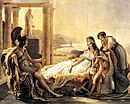Hanno, son of Bomilcar
Hanno (Punic: 𐤇𐤍𐤀, ḤNʾ),[1] distinguished as the son of the suffet Bomilcar, was a Carthaginian officer in the Second Punic War (218 to 201 BC).
Biography
He was a nephew of Hannibal Barca, Carthage's leading general. Hanno's mother was one of Hannibal's three elder sisters.
Travel through the Alps
When Hannibal's army reached the Western bank of the Rhône River, they began preparations to cross. A group of Gauls gathered on the Eastern bank, intent on preventing the army from crossing. Hanno led a small group north, which crossed in small rafts they built. Once across, they headed south toward the Gauls. Hanno sent a smoke signal to inform Hannibal that his force was ready. Hannibal began to send his cavalry across in canoes. As the cavalry attained a foothold on the Eastern bank, the Gauls approached, ready to fight. At this point, Hanno's force attacked the Gauls' rear, causing enough confusion to force the Gauls to retreat.
Campaign in Italy
At the
With the defection of several cities to Carthage in
Hanno led a mostly Bruttian army that captured
Defending Capua
In 212 BC, Hannibal ordered Hanno to arrange provisions for Capua, which was being threatened by the Romans. The Romans had fielded six legions, along with allied units and cavalry units, to besiege Capua (led by prefects Hanno and Bostar), which they were circumventing with double palisades. Hanno, starting from Bruttium, slipped past the army of Gracchus in Lucania, then evaded the respective armies of the two consuls in Samnium, and finally reached Beneventum. He set up camp on a hill and collected provisions from his Samnite allies, then requested some wagons from the Capuans so as to carry the provisions to Capua from his camp.
The tardiness of the Capuans, who were slow to send sufficient wagons, gave time for Quintus Fulvius Flaccus to get wind of the enterprise from loyal Italians, and he attacked the Carthaginian camp when most of Hanno's men were out foraging. Although the Carthaginians succeeded in repulsing the first assault, the Romans were galvanized by the actions of an Italian allied cohort and eventually captured all the supplies and wagons along with the camp.[5]
Hanno, unable to do anything further for Capua, then retired to Bruttium, again evading the Roman armies that could have intercepted him in on the way.[6]
Return to Africa
He reappears in sources as the next commander of the land armies of Carthage after the defeat of Hasdrubal Gisgo. He was replaced by Hannibal himself.
See also
- Battle of Cannae
- Other Hannos in Carthaginian history
References
Citations
- ^ Huss (1985), p. 565.
- ^ Cottrel, Leonard, Hannibal: Enemy of Rome, p. 102
- ^ Bagnell, Nigel, The Punic Wars, p. 240
- ^ Livy's History of Rome Archived 2014-10-23 at the Wayback Machine Bk 24.14 in Everyman's Library edn, vol.4, ed. Ernest Rhys, transl. Rev. Canon Roberts. Dent, London 1905
- ^ Lazenby, J.F., Hannibal's War p. 113-114
- ^ Livy, XXV, p. 13-15
Bibliography
- Huss, Werner (1985), Geschichte der Karthager, Munich: C.H. Beck, ISBN 9783406306549. (in German)
- Lazenby, J. F. (1978). Hannibal's War: A Military History of the Second Punic War. London: Aris and Phillips. ISBN 0-85668-080-X.


